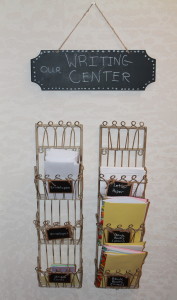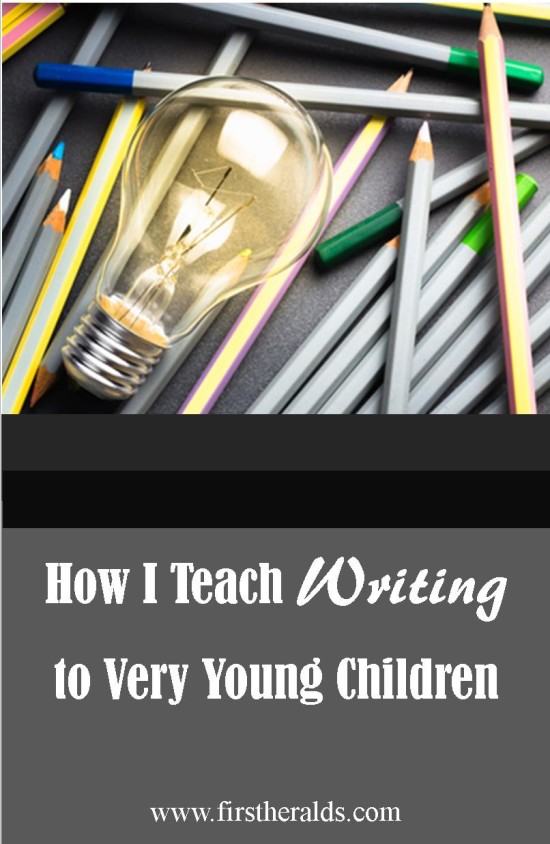Writing is probably my favorite subject to teach. I’m developing a new writing class for children in grades 3 to 5, so I’ve been fielding questions from parents interested in enrolling their children in my class next year. One parent asked whether I will be teaching a similar class for younger kids in kindergarten through 2nd grade. This question caught me slightly off guard, but of course it was a perfectly reasonable question. After all, children in traditional school settings are asked to write at ever-earlier ages. We’re not talking about little kids learning to make their letters or narrating aloud books they have heard. My neighbors’ children are frequently asked to write expository prose in kindergarten. I imagine teachers are hoping to prepare their students for the writing they will be expected to do on standardized testing in second or third grade.
Personally, I never required any of my children to write in any formal way at such a young age. In fact, I never used a writing curriculum until my children reached third or fourth grade, depending on the child. I think if you force a formal writing program on small children, many of them will assume they do not like writing. My boys, in particular, struggled with their fine motor skills when they were little, so it was hard enough just to get them to put a pencil to paper to make their letters. If I had forced them to write good paragraphs or summaries of their reading, I know I would have faced a river of tears and two boys who dreaded writing.
This doesn’t mean I sat back and assumed my children would naturally start writing like they naturally started walking. I knew that my very young children would tend to become writers if I prepared a writing environment for them and allowed them to experiment with writing in informal ways. This is how I’ve always taught my very young children to write; I’ve simply created opportunities for them to “play” with writing.
In this post, I will not go into which writing curricula I’ve used over the years, though I may do a separate post on that subject. Here I’ll focus on how we can create an inviting writing environment for young children.
Modeling
Children want to do what their parents do. As they observe us writing to accomplish every day tasks or perhaps writing in a personal journal or notebook, they will want to copy us. We can invite young children to help us making shopping lists, write cards to family members, or even write emails.
Having a family writing time during which parents and children write together is a wonderful way to foster a love of writing in your children. You can each work on your own writing projects or you can take on a shared family project. You could write your family’s Christmas letter together, create a family newspaper, or write a fictional story complete with illustrations. However, don’t use your family writing time to critique your child’s writing or grammar. Allow family writing time to be light, inviting, and fun.
Writing Center
One of the most effective ways I’ve encouraged my young children to write has been the  introduction of a writing center created just for them. Our writing center is modeled after “message centers” found in Reggio Emilia classrooms. I try to keep it tidy and pretty. We always have writing materials available at the center: pens, pencils, note paper, envelopes, story templates, and blank books. I posted a free PDF of my letter paper and story template here. The center is presented at a child’s level, so the children can gather their writing materials themselves and write whenever they want; they are not limited to writing during a “writing time.”
introduction of a writing center created just for them. Our writing center is modeled after “message centers” found in Reggio Emilia classrooms. I try to keep it tidy and pretty. We always have writing materials available at the center: pens, pencils, note paper, envelopes, story templates, and blank books. I posted a free PDF of my letter paper and story template here. The center is presented at a child’s level, so the children can gather their writing materials themselves and write whenever they want; they are not limited to writing during a “writing time.”
When my youngest child, Lydia, was a toddler and preschooler, her “writing” was often more like drawing. She scribbled. She drew some pictures. She scribbled some more. To most grown-ups, her writing was nothing but squiggly lines. However, when asked about her writing, she would proudly “read” to you her story or note. This is emergent writing, even if we don’t recognize it as such. Now in kindergarten, Lydia spends a lot of time writing notes, making little lists, and creating illustrated stories. Last night, she spent an hour writing Valentine’s Day cards to her friends.
Telling Back Stories and Experiences
For very young children, I follow the example of Charlotte Mason, whose “writing” approach in the early years involves narration (telling back stories the children hear), copywork (copying passages from excellent literature), and dictation (transcribing a passage read aloud by another person). In Charlotte’s classroom, children had their own copybooks which they crafted themselves. They would copy down passages from stories, poems, or from history books. She believed copywork gave children an instinct for good writing. In my home, we do copywork but I do not require as much of it as some Charlotte Mason teachers for the simple reason that my kids get fatigued by too much of it. I believe strongly in the value of dictation, particularly for reinforcing grammar.
I have to say that I disagree with many Charlotte Mason educators who believe copywork, dictation, and narration alone are sufficient to produce quality writers. These tools are useful, but not necessarily sufficient. Why not explain clearly to kids how to write a persuasive essay? How to write a biographical sketch? How to best organize a recipe or instructions for a home-made chicken coop? Yes, kids may develop a good instinct for how to accomplish this if they copy one hundred examples of a recipe or a biographical sketch, but we should also present to them in a more deliberate way the elements of good writing. Kids benefit from formal instruction in the structure of a good essay and the different essay forms; I just think traditional schools start that instruction at too young an age. (And the way traditional schools teach writing is often deadly boring and hopelessly wooden . . . But that’s a topic for a different post . . .)
Hearing Beautiful Stories
Another of Charlotte Mason’s insights that influenced my approach to writing: reading “living books” to children will make them better writers. Living books have real literary power: they are written by inspired and imaginative authors who love what they are writing about. Children enjoy living books, because they appeal to their hearts and emotions — not just their heads. These books will shape our child’s own language, interests, and thinking, which will eventually produce better writing. If children only hear and read “twaddle” — dumbed-down books that are too easy and uninspiring –their writing will suffer because their minds and hearts will suffer. If children do not have access to a complexity of language and ideas, their writing will remain shallow.
Where My Kids Are with Their Writing
My four children are at different stages in their writing and they all have different needs when it comes to writing.
- As described, Lydia (kindergarten) is not required to write; she responds to invitations in our writing environment. She loves to write. Next year, she will begin narrating and copywork.
- Dominic (third grade) tends to make lists and he will write notes to his friends when necessary for some practical purpose, but that’s about it. Of the four children, he is the least interested in writing. He has never had formal writing instruction beyond narrating , dictation, and copywork, but he will begin my writing program this fall.
- Claire (seventh grade) has always written copious stories, created comic books, and kept logs of her collected treasures. She did a lot of narration, dictation, and some copywork, and she has been enrolled in a formal writing program for a few years. She doesn’t love the formal writing instruction unless it’s creative writing, but she’s a funny and vivid writer.
- Aidan (eleventh grade) did narrations , a lot of dictation, and some copywork in his early elementary years and he learned the basics of paragraph construction in about fourth grade. In fifth grade, he began writing book reports, which are really written narrations. He started a formal writing program that introduced different essay forms when he entered the seventh grade. By the public school standards in my state, he was an early reader, but a late writer. Yet, he is now a powerful, electrifying writer. Best of all, he likes to write, especially persuasive pieces on Christian apologetics or on controversial moral issues. I guess my approach worked out well for him.
Just because I don’t teach writing to little children doesn’t mean you shouldn’t do so with your own. I say trust yourself as your child’s first and most important teacher. I don’t have a perfect formula that works for every child and that is why my children have learned to write in different ways at different points in their academic journey. As in all things in my homeschooling, I’ve learned to trust my gut as I learn to understand my children and their writing. I observe them and respond to their unique learning needs, and I think every homeschooling parent should do the same. I’m confident, though, that creating an encouraging writing environment will benefit every young child.
